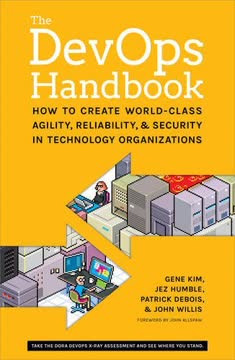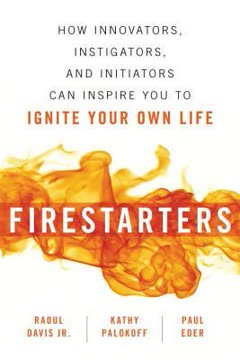Key Takeaways
1. Teal Organizations: A New Paradigm of Self-Management and Purpose
"Organizations as we know them are a very recent invention, but are so omnipresent that we rarely stop to think about whether they are the best possible fit for our values and worldviews."
A paradigm shift. Teal Organizations represent a fundamental reimagining of how businesses can operate, moving beyond traditional hierarchies and profit-focused models. This new paradigm emphasizes self-management, wholeness, and evolutionary purpose as its core principles.
Historical context. The book traces the evolution of organizational models through various stages of human consciousness, from early tribal structures to modern corporations. Teal represents the next step in this evolution, offering a more holistic and adaptive approach to work and organizational life.
- Stages of organizational evolution:
- Red: Impulsive, short-term focus
- Amber: Formal roles, stable processes
- Orange: Innovation, accountability, meritocracy
- Green: Empowerment, values-driven culture
- Teal: Self-management, wholeness, evolutionary purpose
2. The Three Breakthroughs: Self-Management, Wholeness, and Evolutionary Purpose
"Self-management, wholeness, and evolutionary purpose: these are the three breakthroughs that characterize Teal Organizations."
Self-management. This principle replaces traditional hierarchies with distributed decision-making and peer relationships. It allows for greater agility and employee engagement by trusting individuals to make decisions within their areas of expertise.
Wholeness. Teal Organizations encourage employees to bring their full selves to work, embracing all aspects of their personalities and skills. This fosters authenticity, creativity, and deeper connections among colleagues.
Evolutionary purpose. Instead of being driven solely by profit or market share, Teal Organizations are guided by a sense of purpose that evolves over time. They view themselves as living entities with their own direction and potential.
3. Self-Management: Distributing Power and Decision-Making
"With no scarce promotions to fight for, no bosses to please, and no adversaries to elbow aside, much of the political poison is drained out of organizations."
Decentralized authority. In Teal Organizations, decision-making power is distributed throughout the organization. Employees are trusted to make decisions within their roles, consulting with relevant colleagues when necessary.
Advice process. Instead of top-down approvals, Teal Organizations use an "advice process" where individuals seek input from affected parties and experts before making decisions. This ensures that diverse perspectives are considered while maintaining individual autonomy.
- Key elements of self-management:
- No formal hierarchy or job titles
- Fluid roles based on skills and interests
- Peer-based conflict resolution
- Transparent information sharing
4. Wholeness: Bringing One's Full Self to Work
"Workplaces where we feel we can show up with all of who we are unleash unprecedented energy and creativity."
Authenticity encouraged. Teal Organizations create environments where employees feel safe to express their true selves, including their emotions, intuitions, and vulnerabilities. This leads to more genuine relationships and increased engagement.
Practices for wholeness. Many Teal Organizations implement specific practices to foster wholeness, such as reflective spaces, storytelling sessions, and team-building activities that go beyond superficial interactions.
- Examples of wholeness practices:
- Meditation or mindfulness sessions
- Personal development workshops
- Encouraging hobbies and interests at work
- Open and honest feedback mechanisms
5. Evolutionary Purpose: Organizations as Living Entities
"Teal Organizations are seen as having a life and a sense of direction of their own."
Purpose-driven. Rather than being solely focused on profit or market share, Teal Organizations are guided by a deeper sense of purpose that evolves over time. This purpose acts as a compass for decision-making and strategy.
Listening to the organization. Leaders and employees in Teal Organizations strive to "listen" to the organization's purpose and direction, rather than imposing their own will upon it. This requires a shift in mindset from controlling to sensing and responding.
- Characteristics of evolutionary purpose:
- Flexible and adaptive strategies
- Focus on long-term value creation
- Alignment of individual and organizational purpose
- Openness to change and new directions
6. Necessary Conditions: Leadership and Ownership Alignment
"The level of consciousness of an organization cannot exceed the level of consciousness of its leader."
Leadership mindset. For a Teal Organization to thrive, its top leadership must embrace the Teal worldview and be willing to distribute power and trust in self-management principles.
Ownership alignment. The owners or board of the organization must also understand and support Teal practices. Without this alignment, there's a risk of reverting to traditional management approaches during challenging times.
- Key factors for successful Teal implementation:
- CEO with Teal mindset
- Board members who understand and support Teal principles
- Willingness to fundamentally rethink organizational structures
- Patience and persistence during the transition
7. Practical Implementation: Starting or Transforming Organizations
"Starting with a clean slate, you can listen in to the organization's purpose and shape the culture, the practices, the people you recruit, and other factors, accordingly."
Starting fresh. When creating a new Teal Organization, founders have the opportunity to build Teal practices from the ground up. This includes carefully selecting co-founders and early employees who align with Teal principles.
Transforming existing organizations. For established organizations transitioning to Teal, the process can be more challenging. It often involves a gradual shift, starting with one or two Teal practices and expanding over time.
- Steps for implementing Teal practices:
- Assess leadership and ownership alignment
- Educate employees about Teal principles
- Start with pilot projects or departments
- Gradually expand self-management practices
- Foster a culture of trust and experimentation
8. Cultural Shift: From Control to Trust and Empowerment
"Trust is so countercultural that it needs to be defended and reaffirmed every time a problem arises."
Building trust. A key aspect of Teal Organizations is the shift from a culture of control to one of trust. This requires leaders to let go of traditional control mechanisms and trust employees to make decisions.
Empowerment and responsibility. With increased trust comes greater empowerment for employees. However, this also means taking on more responsibility and being accountable to peers rather than superiors.
- Elements of a trust-based culture:
- Transparent information sharing
- Emphasis on peer relationships
- Celebrating mistakes as learning opportunities
- Encouraging initiative and experimentation
9. Adapting Structures: Fluid Roles and Organic Hierarchy
"There are no job descriptions, no job titles, no promotions. Work is organized through a system of freely created roles that people fill, exchange, or leave behind according to their interests and talents."
Flexible roles. Instead of rigid job descriptions, Teal Organizations use fluid roles that can adapt to changing needs and individual strengths. This allows for greater flexibility and personal growth.
Natural hierarchies. While formal hierarchies are eliminated, natural hierarchies of expertise and influence emerge based on skills, experience, and peer recognition.
- Examples of structural adaptations:
- Self-forming teams around projects or client needs
- Rotation of leadership roles
- Cross-functional collaboration without formal departments
- Peer-based performance evaluations
10. Information Flow and Decision-Making in Teal Organizations
"All business information is open to all."
Radical transparency. Teal Organizations operate with a high degree of transparency, making most business information available to all employees. This enables better decision-making and fosters trust.
Collective intelligence. By distributing decision-making and encouraging input from all levels, Teal Organizations tap into the collective intelligence of their workforce. This often leads to more innovative and effective solutions.
- Decision-making practices:
- Advice process for major decisions
- Real-time information sharing platforms
- Open-book management
- Regular all-hands meetings for updates and discussions
11. Challenges and Resistance in Transitioning to Teal
"Expect their resistance to be the hardest nut to crack in your organization's transition."
Middle management resistance. One of the biggest challenges in transitioning to Teal is overcoming resistance from middle managers, who may feel threatened by the loss of their traditional roles and power.
Mindset shifts. Employees accustomed to traditional hierarchies may struggle with the increased responsibility and autonomy of Teal practices. This requires patience and support during the transition.
- Common challenges in Teal transitions:
- Resistance from those in power
- Initial confusion and uncertainty
- Difficulty in measuring performance
- Balancing freedom with accountability
- Maintaining Teal practices during crises or rapid growth
12. The Future of Work: Teal as a Model for Organizational Evolution
"The more clarity there is around what the organization is called to do, the more people can enter into resonance with it."
Evolving workplace. Teal Organizations represent a potential future for how we organize work, aligning with growing desires for purpose, authenticity, and self-actualization in the workplace.
Broader impact. As more organizations adopt Teal practices, it could lead to wider societal shifts in how we view work, leadership, and organizational structures.
- Potential impacts of Teal Organizations:
- Increased employee engagement and well-being
- More adaptive and resilient businesses
- Greater alignment between personal and organizational values
- Shift towards more sustainable and purpose-driven economies
- Redefinition of success beyond financial metrics
Last updated:
FAQ
What's Reinventing Organizations about?
- Exploration of Organizational Models: Reinventing Organizations by Frederic Laloux examines the evolution of organizational structures, focusing on how they align with different stages of human consciousness.
- Teal Organizations: It introduces "Teal Organizations," which operate on principles of self-management, wholeness, and evolutionary purpose, contrasting them with previous models like Amber, Orange, and Green.
- Historical Context: The book provides a historical perspective, tracing organizational development from Impulsive-Red to Evolutionary-Teal, highlighting the shift towards more human-centered practices.
Why should I read Reinventing Organizations?
- Innovative Framework: The book presents a groundbreaking framework for creating organizations aligned with human values and potential, relevant in today's changing work environment.
- Real-World Examples: It includes case studies from various sectors, demonstrating successful implementation of Teal principles and offering practical insights for leaders.
- Inspiration for Change: The book serves as a source of inspiration for leaders and change-makers aiming to foster more meaningful and productive work environments.
What are the key takeaways of Reinventing Organizations?
- Three Breakthroughs: The book identifies self-management, wholeness, and evolutionary purpose as key breakthroughs of Teal Organizations, enabling effective operation without traditional hierarchies.
- Living Systems Metaphor: Laloux suggests viewing organizations as living systems, emphasizing adaptability, interconnectedness, and organic growth.
- Empowerment and Trust: A central theme is the importance of trust and empowerment in fostering a culture where employees feel responsible and engaged.
What is the concept of "Teal Organizations" in Reinventing Organizations?
- Self-Management: Teal Organizations empower teams to make decisions without hierarchical oversight, encouraging autonomy and accountability.
- Wholeness: They promote a culture where employees can bring their whole selves to work, integrating emotional, spiritual, and rational aspects.
- Evolutionary Purpose: Guided by a sense of purpose that evolves over time, these organizations adapt to changing circumstances and needs.
How does Laloux define "self-management" in Reinventing Organizations?
- Peer Relationships: Self-management is characterized by peer relationships, allowing for collective decision-making without power hierarchies.
- Advice Process: Decisions are made through an "advice process," where input is sought from affected parties and experts, ensuring diverse perspectives.
- No Hierarchical Control: Traditional hierarchical roles are eliminated, fostering a fluid and dynamic approach to leadership and accountability.
What are the practices that support self-management in Teal Organizations?
- Team Autonomy: Teams handle their own operations, including hiring and budgeting, encouraging ownership and commitment to goals.
- Regular Reflection: Teams engage in reflection and feedback sessions to assess performance and make adjustments, fostering continuous improvement.
- Minimal Staff Functions: By maintaining minimal staff functions, teams handle administrative tasks, reducing bureaucracy and enhancing efficiency.
How does Reinventing Organizations address the issue of power dynamics?
- Trust Over Control: The book emphasizes operating on trust rather than control, allowing employees to take initiative without fear of punitive measures.
- Fluid Hierarchies: While traditional hierarchies are removed, expertise-based hierarchies emerge organically, allowing natural leadership to arise.
- Collective Responsibility: Everyone shares responsibility for outcomes, reducing blame culture and fostering a sense of community and collaboration.
What are some real-world examples of Teal Organizations mentioned in Reinventing Organizations?
- Buurtzorg: A Dutch nursing organization with self-managing teams, focusing on holistic patient care and employee empowerment.
- FAVI: A French brass foundry that allows teams to make production and quality decisions without traditional management oversight.
- AES: A global energy provider that implemented self-managing teams, demonstrating success without hierarchical control.
What challenges do organizations face when transitioning to a Teal model?
- Cultural Resistance: Organizations often face resistance from employees accustomed to traditional hierarchies, requiring strong leadership and vision.
- Skill Development: Employees may need training in self-management and collaboration to operate effectively in a Teal environment.
- Maintaining Trust: Maintaining trust and open communication is essential during the transition, with leaders modeling desired behaviors.
What is the advice process mentioned in Reinventing Organizations?
- Decentralized Decision-Making: The advice process allows any employee to make decisions after seeking input from relevant colleagues.
- Encourages Collaboration: This method fosters collaboration, leading to better-informed decisions by consulting others.
- Empowerment and Responsibility: Employees feel empowered to take ownership of their work, creating a sense of shared purpose.
How do Teal organizations handle conflict resolution?
- Peer-Based Processes: Conflicts are addressed among peers rather than escalated to a manager, promoting mature dispute resolution.
- Training in Conflict Resolution: Employees are trained in effective techniques, ensuring all team members can handle disputes.
- Focus on Relationships: Emphasis is on maintaining healthy relationships and finding mutually agreeable solutions.
What are the best quotes from Reinventing Organizations and what do they mean?
- "You never change things by fighting the existing reality.": This quote by Richard Buckminster Fuller encapsulates the need for innovative models that transcend outdated practices.
- "Fear breeds fear and trust breeds trust.": Highlights how organizational culture can foster a positive or negative environment based on underlying assumptions.
- "The world knows how to create itself.": Emphasizes allowing organizations' inherent purpose to emerge naturally, rather than controlling every aspect.
Review Summary
Reinventing Organizations receives mostly positive reviews, with readers praising its innovative ideas on organizational management. Many find the book thought-provoking and inspirational, appreciating its exploration of self-management and purpose-driven organizations. Some criticize the author's spiritual language and lack of critical analysis. Readers value the practical examples and case studies provided. While some find the concepts challenging to implement, many see the book as an important contribution to reimagining workplace structures and human potential in organizations.
Similar Books







Download PDF
Download EPUB
.epub digital book format is ideal for reading ebooks on phones, tablets, and e-readers.





